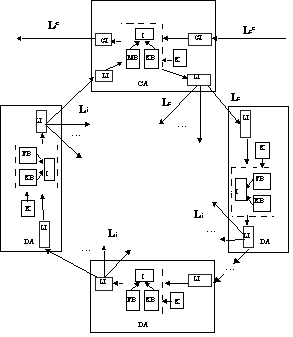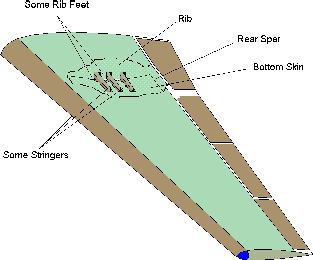 |
||
Intelligent Distributed Mismatch Control: MODEL and APPLICATION
V.V. Taratoukhine1, 2, K. Bechkoum2
1Ulyanovsk State Technical University, Russia
2
De Montfort University, Englandјннотаци€
Ц ѕредлагаема€ стать€ рассматривает существующие методы контрол€ ошибок при совмещенном проектировании сложных технических систем, в частности в самолетостроении. ¬ысока€ степень неопределенности прин€ти€ проектных решений, естественное наличие ошибок на ранних стади€х проектировани€ обуславливает необходимость применени€ методов распределенного искусственного интеллекта - многоагентных систем. –азработана архитектура многоагентной системы и рассматриваетс€ ее приложение к виртуальному моделированию сборки кессона самолета AIRBUS A340.Introduction
One of the key challenges for Europe is to maintain and develop the European Aerospace sector as a world competitive industry. In the Fifth Framework Programme of the EC financial support dedicated to Aerospace industry alone is set to euro 700 million. This increased financial support reflects the need for the aerospace industry to make use of emergent technologies that enable an integrated approach for European cooperation.
For many years the design and manufacture of the major European aerospace products has been distributed across the continent; Airbus and EFA being typical examples. In this paper we focus on one aspect of the distributed design process: intelligent distributed design consistency checking. The implementation of the research carried out in the aerospace design.
Research into the use of knowledge engineering in design has become widely accepted as a fast growing subfield of Artificial Intelligence (AI). Increasing numbers of researchers, and research groups, are active within this emerging subfield [1-4].
The AI technologies used are varied and include expert systems [3][6], genetic algorithms [4] and evolution programming neural networks [5], fuzzy logic [6] and multi-agent systems [7][8].
It is fair to say though, that design engineers are still skeptical about the ability (or inability) of current intelligent design-support systems. For example, even when endowed with some sort of intelligent behaviour, existing CAD/CAE systems cannot handle several types of inconsistencies that may occur during the design phase. In most of the previous work all the design knowledge is centralised into one unit: the knowledge base[1]. The centralisation of knowledge coupled with the absence of a negotiation mechanism (between all parties involved in the design) makes the process of predicting the impact of any modification an (almost) impossible task.
The paper [3] describes an Intelligent Mismatch Control System (IMCS) which has the potential to detect some types of mismatches. The IMCS implementation is an important step towards a more comprehensive solution but is far from being defects free. For example, the number and types of mismatches handled by the system is narrowed down to a few geometric mismatches.
The work presented here takes the IMCSТ development one step forward. A new multi-agent architecture is proposed which gives the IMCS the ability to handle issues peculiar to the nature of distributed design. This multi-agent architecture will be at the heart of an intelligent distributed mismatch control system (IDMCS) that aims at ensuring that the overall design is consistent and acceptable to all.
Problem
The problem becomes that of creating a conceptual framework for building a knowledge-based mismatch control system. The framework is based on a community of agents which are capable of learning and/or adapting to changes in the environment.
In order to contribute towards a solution to the above problem the following steps were taken:
-define a taxonomy of distributed design mismatches.
-develop a Conceptual Framework for a multi-agent system that handles these mismatches. This should take into account:
-the design knowledge needed to be considered whithin each agent.
-the knowledge representation paradigm.
-communication and negotiation issues, including conflict resolution.
A Taxonomy of mismatches in design
The problem of devising a fully-fledged taxonomy for design mismatches is a very complex one. This is because design is a multi-disciplinary task that involves several stages. These stages include input data analysis, conceptual design, basic structural design, detail design, production design, manufacturing processes analysis, and documentation.
A broad classification based on geometrical mismatches is represented in [3].
Our taxonomy uses some of these known parameters, but is especially oriented for implementation for mismatch detection during the integration phase of mechanical engineering design. It is particularly useful when dealing with a design assembly process. In this case, the different CAD models are assumed to be error-free. Within the proposed taxonomy critical parameters are identified. It is the variation of these parameters that causes a mismatch.
For instance weld connections require accordance between types of materials and material thickness, as well as, geometric parameters of material.
The bolted connection requires critical parameters such as thread major diameter, minor diameter and pitch to be in accordance.
For the correct mismatch detection process we need to represent into our knowledge-base geometric information and information about materials from which parts are prepared.
Formal description of the multi-agent framework
The conceptual framework of the IDMCS is shown in Fig.1.
 Figure 1: A
multi-agent framework
Figure 1: A
multi-agent framework
The architecture assumes that the design knowledge is encapsulated within the different members of agent community. Conceptual framework (CF) may be formally presented formally as follows:
CF = {AP1, ... , APt, ... , APn},
where
APt is the tth Assembly Part, t = 1,2, Е , n.
AP={DA1, Е , DAi, ... , DAm, CA1, ... , CAj, Е ,CAk},
DAi is the ith Design Agent (D-agent),
i = 1, 2, Е, m,
CAj is the jth Control Agent (C-agent),
j = 1, 2, Е, k.
Each DAi consists of eight elements: FB - facts base, which including information about geometric characteristics of the part and material type. KB - knowledge-base. K - corrector block - which is adapted knowledge-base, as the result of communications with any other agents. I - inference engine. LI - local interface mechanism.
The organisation of the distributed knowledge-base is presented as follows:
FB of D-agent including frame facts containing information about parts geometric and material consistency.
Rules in KB and MB of D- and C-agents provide analysis of design situation using experts knowledge. These rules can be represented as normal and/or fuzzy rules.
Each CAj consists: MB - metaknowledge base, knowledge-base of control agent, interference engine, corrector block, local and global interface mechanism (GI).
Communications is key ability of multi-agents systems. The proposed communication protocol (CP) for the above agents is as follows:
CP={Lc1, ... , Lcm; Li1, ... ,Lim; Lcc1, ... , Lcck; Lic1, ... , Lick},
where: Li - information language, which describes current situation into multi-agent system, Lc - control language, which includes imperative commands about adaptation fact base of design agent for mismatch improvement, adaptation and modification D-agentТs knowledge-base. Lic - information language, which describes current situation for control agents, Lcc - control language, which adapt meta- and knowledge-base of C-agents.
We represent conceptual framework as community of schedule and reactive agents. In our case D-agent is a reactive agent, which negotiate with other D-agents using designТ schedule (assembly sequence) generating C-agent.
Each D-agent is operated as independent entity and interactes asynchronously with other D-agents on peer-to-peer level and client server architecture (under the supervision of the C-agent).
D-agents are endowed with the capacity of negotiation with one another to ensure that any mismatches are detected and that a solution is proposed, but do not modify each other, because that is responsibility of C-agents.
C-agent receives the new information from D-agents using syntax of Li, negotiate with other C-agents, using Lic and Lcc , and updates the D-agents fact- and knowledge base using Lc, if mismatches occur.
Wing Box Digital Mock-up
Underlying this research was the hypothesis that current CAD/CAM/CAE systems do not support the mistatch control process described later.
The IDMCS designed by the authors is a distributed knowledge-based design support system which detects geometric and material irregularities at the assembly stage.
In collaboration with Electoimpact Inc. (British Aerospace Airbus, Broughton) a set of practical investigations of work practice and technology usage were designed. A wing box is the structural component of an aircraft wing [9] (see figure 2).
The wing box model consists of several parts - stringers, skins, spars, ribs and connection details Ц boltlocks and rivets. In a large aircraft wing there can be over 50 ribs and 100 stringers.
When designing, the following steps are being performed: (1) analysis of assembly parts - Assembly checks of stringers, skins, spars and etc., (2) analytically evaluation of assembly possibility - Collision and Tolerance Analysis, (3) choosing the script (conditions) of virtual mock-up, and (4) progress analysis and generation of results.
 Figure
2: A340 Wing construction
Figure
2: A340 Wing construction
The system analyses designer requirements to the design project given in the form of geometric information and processes at the level of the distributed knowledge base. IDMCS is developed using a ZEUS toolkit (British Telecommunications plc).
Conclusion and future work
In this paper we have proposed a conceptual network for building a knowledge-based mismatch control system, which would be capable of detecting potential mismatches and proposing a rational way to deal with them.
The implementation of initial version of Intelligent Distributed Mismatch Control System (IDMCS) for aerospace design is also outlined.
The next step is a creation of extended prototype of IDMCS, which will liable us to evaluate the effectiveness of the proposed framework for wide area applications as aerospace and automotive industry. On this stage possibility for implementation of neural networks for agaptation D- and C-agentТs knowledge-base will be investigated.
References
[1] V. Akman, P.J. ten Hagen, and T. Tomiyama, УA Fundamental and Theoretical Framework for an Intelligent CAD System,Ф Computer Aided Design Journal, Vol. 22, pp. 352-367, 1990.
[2] V. Tarassov, L. Kashuba, УConcurrent Engineering and AI Methogologies: Opening New FrontiersФ, Concurrent Engineering EuropeТ97, Bulding TomorrowsТs Virtual Enterprise, April 16-18, Erlangen-Nuremberg, Germany, SCS International publication, pp.869-888, 1997.
[3] K. Bechkoum, УIntelligent Electronic Mock-up for Concurrent Design,Ф Expert Systems with Applications Journal, Vol. 12, pp. 21-36, 1997.
[4] J. S. Gero, УAdaptive Systems in Designing: New Analogies from Genetics and Developmental Biology,Ф in Adaptive Computing in Design and Manufacture, I. Parmee (ed.), Springer, London, 1998.
[5] D. D. Daberkow, and D. N. Marvis, УNew Approaches to Conceptual and Preminary Aircraft Design: A Comparative Assessment of a Neural Network Formulation and a Response Surface Methodology,Ф Proceedings of World Aviation Congress and Exposition, Anaheim, CA, USA, Paper N. SAE-985509, 1998.
[6] I. V. Semoushin, V.V. Shishkin, and V. V. Taratoukhine, УKnowledge-based Network Simulation SystemФ, Proceedings of the 7th International Fuzzy Systems Association Congress, Czech Republic, Prague, pp. 532 Ц 537, 1997.
[7] V. V. Taratoukhine K. Bechkoum, УTowards a Consistent Distributed Design: A Multi- Agent ApproachФ, Proc Information Visualisation '99, London, IEEE Press, 1999.
[8] K. Bechkoum, V. V. Taratoukhine УA Framework for Mismatch Control in a Distributed Design EnvironmentФ, Proc. Advances in Concurrent Engineering, Bath, 1-3 September, 1999.
[9] Knowledge based engineering at Airbus, British Aerospace Airbus, 1999
| Site of Information
Technologies Designed by inftech@webservis.ru. |
|